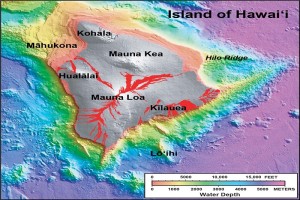VOLCANO WATCH: A geological tour of the Hawaiian Islands (Hawai’i)

: In this shaded relief and bathymetric map of the Island of Hawai‘i, colors indicate water depth, from shallow (orange and yellow) to deep (blue and purple), and shades of gray indicate the land area above sea level. From: U.S. Geological Survey Geologic Investigations Series Map I-2809, “Hawaiʻi’s Volcanoes Revealed.”
As the 2016 Volcano Awareness Month comes to an end, so too does our series of “Volcano Watch” articles exploring the geology of the Hawaiian Islands. This week, we conclude our journey with the Island of Hawaiʻi.
As you likely already know, the Island of Hawai‘i is made up of five volcanoes. From oldest to youngest, they are Kohala, Hualālai, Mauna Kea, Mauna Loa, and Kīlauea.
Less well known is a sixth volcano—Māhukona—located just off the island’s northwest coastline. This submarine volcano is the oldest of the volcanoes that form the mass of Hawai‘i. Māhukona last erupted about 300,000 years ago, but its geology is not as well-studied as its taller neighbors because it is not easily accessible.
Kohala began erupting just over 1 million years ago. The southeast rift zone of this volcano gives it substantial length, extending beneath Mauna Kea and continuing as the offshore Hilo Ridge. Kohala is capped by postshield lava as young as about 120,000 years. While its postshield volcanism is probably over, rejuvenated eruptions might occur in the future—perhaps even millions of years from now, as has occurred on the islands of Oʻahu and Kauaʻi. In the meantime, Kohala will continue to erode, from both rain and catastrophic collapse, causing the volcano to become more rugged as time passes.
Hualālai and Mauna Kea, the next oldest volcanoes, share many characteristics. Both formed less than 1 million years ago and are now in the postshield stage. Their surfaces are dotted with cinder cones—the remnants of mildly explosive postshield eruptions. Mauna Kea is slightly younger, with its most recent eruption around 4,500 years ago, but Hualālai erupts more frequently. Although Mauna Kea will probably erupt again in the future, Hualālai is of more concern, because it erupted just 215 years ago (in 1801) and looms above numerous towns along the island’s Kona coast. Both volcanoes are in the waning stages of their lives, and their ages are beginning to show in the valleys that are carved into their flanks—especially along the Hāmākua coast on Mauna Kea.
In contrast, Mauna Loa and Kilauea are in the primes of their lives.
Mauna Loa is the largest active volcano on Earth. Its most recent eruption was in March 1984, but the volcano’s almost-32-year-long slumber is deceptive, as Mauna Loa’s long-term history reveals that it typically erupts every 5-6 years. Mauna Loa will certainly erupt again, and the odds are that many of us will live to see it. Even now, the volcano is inflating as magma accumulates beneath it.
What Kilauea lacks in size (compared to Mauna Loa), it makes up for with persistence of eruptive activity. The volcano has erupted more often than not for the past several hundred years and has produced a nearly steady stream of lava since 1983.
Geologic investigations of Kilauea’s past reveal that the volcano alternates between periods dominated by explosive activity and periods dominated by effusive eruptions (lava flows). In some ways, Kilauea might be analogous to a volatile teenager—prone to occasional fits of temper and overall unsettled behavior, all while growing rapidly. This maturation process takes time, and Kilauea’s shield-building stage likely has hundreds of thousands of years to go before it ends.
Although not yet part of the island, another submarine volcano—Lōʻihi—bears mentioning. If Kilauea is a teenager, Lōʻihi is a mere toddler. The volcano is currently 30 kilometers (20 miles) off the south coast of the Island of Hawaiʻi and about 1000 meters (3300 feet) below sea level. Seaward growth of Kilauea and Mauna Loa, coupled with the growth of Lōʻihi as the volcano matures, may eventually connect the volcanoes above sea level.
We hope you’ve enjoyed our geological tour of the Hawaiian Islands over the past four weeks and that you were able to attend one or more of the Volcano Awareness Month talks offered by the USGS Hawaiian Volcano Observatory in January. Although the month is ending, volcano awareness can (and should) continue all year long.
Volcano Activity Updates
Kīlauea continues to erupt at its summit and East Rift Zone. During the past week, the summit lava lake level was relatively stable, varying between about 35 and 38 m (115–125 ft) below the vent rim within Halema‘uma‘u Crater. On the East Rift Zone, scattered lava flow activity remains within about 6 km (4 mi) of Puʻu ʻŌʻō, and is not currently threatening nearby communities.
Mauna Loa is not erupting. Seismicity remains elevated above long-term background levels, with earthquakes occurring mostly beneath the volcano’s upper Southwest Rift Zone at depths less than 5 km (3 mi) during the past week. Continuously recording GPS instruments show deformation related to inflation of a magma reservoir beneath the summit and upper Southwest Rift Zone of Mauna Loa, with inflation recently occurring mainly in the southwestern part of the magma storage complex.
There were no earthquakes reported felt on the Island of Hawai‘i during the past week.
Volcano Watch is a weekly article and activity update written by scientists at the U.S. Geological Survey`s Hawaiian Volcano Observatory.













